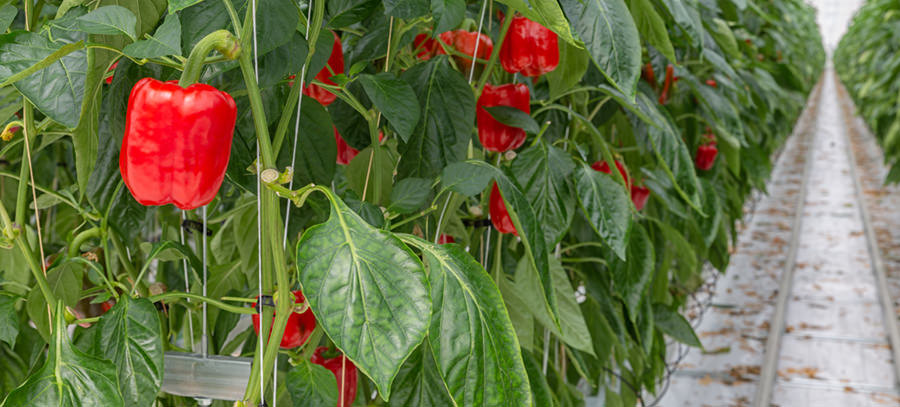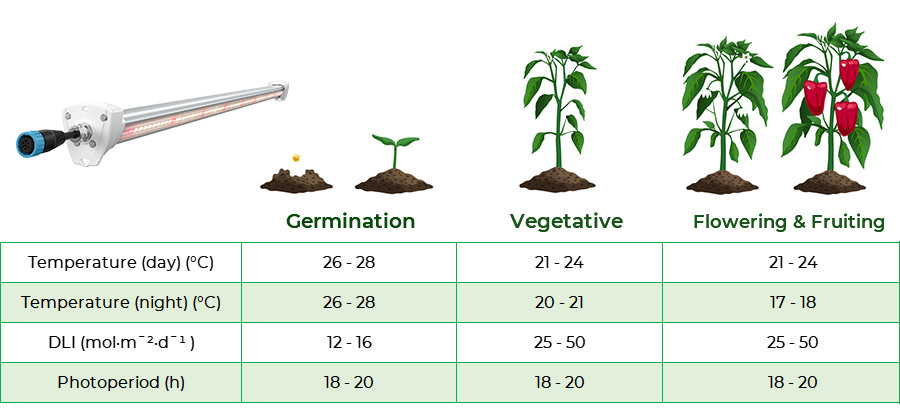The Guide to Increase Greenhouse Pepper Yield
When it comes to pepper, most people may think of delicious salads or pizzas. Peppers enrich texture and flavour of foods. They are also nutritious, containing a large amount of vitamin C and vitamin B6. Thus, peppers are widely used and planted around the world. Pepper is one of the most popular commercial crops grown with greenhouse as well. Tough greenhouse peppers are of significantly higher yield compared to conventional cultivation, human are still facing the challenge of climate change and food shortage. Furthermore, higher yield is equal to more profits generally. As a result, growers and researchers are never stop finding the way to achieve greater yield. Environment management, including temperature and lighting control, is the key point that affects greenhouse peeper yield. This post would like to talk about the optimum temperature and lighting to increase greenhouse pepper yield.

Pepper production
Peppers are warm season and slow-growing crops. They can be green, yellow, and red in color. Traditional field-grown peppers are limited under cold weather conditions. Therefore, greenhouse are originally used in winter, fall, and early spring. Nowadays, modern greenhouse has made year-round pepper production come true. Peppers grow slower than other vine crops, such as tomatoes and cucumbers. Pepper seeds cost 1-2 weeks to sprout after sowing. Reducing water supply in this period will force the roots to plunge deeper into the soil. 2-3 weeks later, growers can transplant the seedlings. It takes about 65 to 75 days from transplanting to maturity. Pepper plants begin to develop flowers and fruits 5-7 weeks after transplanting. Water and nutrients supply should be increased during this period. Around 3-4 weeks later, fruits turn to maturity and it is time for first harvest. Greenhouse peppers are generative with long lasting harvest up to 6 months. Thus, although peppers are of slower speed, they are still profitable.
Temperature
Generally speaking, temperature tolerance range of peppers is 15°C to 32°C (60°F to 90°F). Either over high or low temperature is negative to pepper growth. As mentioned before, peppers are warm season crop. Higher temperature is beneficial for setting fruits. However, temperature exceeded 32°C (90°F) will cause pollen sterility and flowers drop. Excessive high temperature may also cause pepper plants to wilt even the soils are wet enough. Too low a temperature, in contrast, is detrimental to set fruit. Temperature lower than 15°C (60°F) makes peppers difficult to set fruit and resulting poor fruit set. Higher day temperature combined with lower night temperature allow plants store more energy and improve flavour.
Optimum temperature varied from growing stage and day or night time. Temperature between 26°C - 28°C is suitable for germination stage. 21°C - 24°C (70°F - 75°F) day temperature and 20°C - 21°C (68°F - 69°F) night temperature are great for vegetative stage. For fruiting stage, 21°C - 24°C (70°F - 75°F) day temperature and 17°C - 18°C (63°F - 64°F) night temperature are optimum.
Lighting
It goes without saying that light is critical for plants. Plant productivity is closely related with light availability. Artificial supplemental lights and greenhouse provide an opportunity for year-round production even in winter. Artificial lights like LED grow lights are used to simulate sunlight and supplement lights under insufficient lighting condition. Spectrum, lighting intensity, photoperiod, and their effects on plants are taken into account to figure out the optimal lights for specific goals of greenhouse pepper.
-
Light spectrum
Light spectrum related with plant growth is divided into UV light (100 - 400 nm), blue light (400 - 500 nm), green light (500 - 600 nm), red light (600 - 700 nm), and far-red light (700 - 850 nm). This range of wavelength sensed by plants is not all perceivable by human eyes. Wavelength ranges from 400 nm to 700 nm is defined as Photosynthetically Active Radiation (PAR). That is why most LED grow lights are designed in PAR range. Red/ far red light influence phytochrome content while UV-A and blue light have effects on Cytochrome. Small amount of far-red light promotes fruit production to greenhouse peppers.
-
Light intensity
Light intensity measured by PPFD(µmol·m-2s-1), which means the total number of PAR photo per square meter per second. Research found that supplement lighting with intensity of 120 µmol·m-2s-1 significantly increased the total pepper production by 18% to 33%. Besides, it also showed that the optimal lighting intensity for vegetative stage was about 180 µmol·m-2s-1. To calculate the light intensity and manage the supplemental lights more precisely, DLI (Daily Light Integral) is introduced. DLI (mol·m-2·d-1 ) is the amount of PAR delivered per unit area during 24 hours. Peppers require high light condition for robust and generative growth, so DLI ranged from 25 - 50 mol·m-2·d-1 is recommended for greenhouse pepper.
-
Photoperiod
Photoperiod is the period of uninterrupted light in a day (24 hours) that plants are exposed to. Natural lights are changed along with rolling on season, and plants react to the lengths of light exposure. Controlling the photoperiod is able to bring forward growth stage, which means the possibility of earlier marketing and primary price. Therefore, except for spectrum and light intensity, photoperiod is vital for greenhouse peppers. A photoperiod between 18 to 20 hours but not over 21 hours is perfect for pepper production.
-
Greenhouse pepper lighting solution
Another factor that can not be ignored is the lighting distribution of supplemental lights. Peppers in greenhouse are grown vertically. Top lights emits the lights and shine the upper part of pepper plants. Lower part of plants may shaded by large leaves, resulting insufficient lighting. Atop provides Horti-Reina, an ideal interlighting system for greenhouse pepper production. Horti-Reina spreads the light more evenly over the canopy and supplements light for the middle part of the crop, thereby promoting the development of flower.
Supplemental lights should be adjusted according to specific needs of each growth stage. A mixture of red and blue light benefits plant morphology and robust growth for seedlings. Lighting intensity up to 180 µmol·m-2s-1 encourage pepper plants adapted to greenhouse environment at transplanting stage. For flowering and fruiting, sufficient lighting intensity and period is irreducible. Horti-Reina is available with customized spectra, lengths, and mounting possibilities, matching specific needs for various growing stage and goals.
To sum up, here is a table of recommended temperature and lighting for greenhouse pepper.


